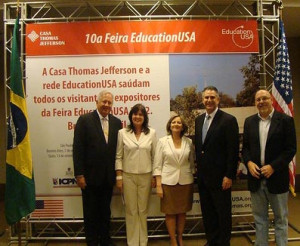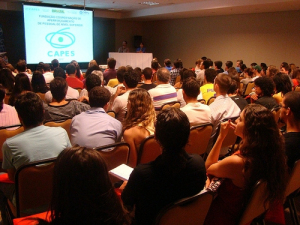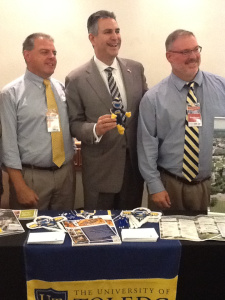This post contains external links. Please review our external linking policy.
Braeden Young is an International Trade Specialist and Brazil Desk Officer within the International Trade Administration.
Brazil, which became the world’s sixth-largest economy last year, is bustling with activity. As Brazil ramps up preparations for hosting the 2014 FIFA World Cup and the 2016 Olympic Games, opportunity abounds for U.S. companies to support infrastructure development at sports venues, surrounding communities and commercial centers, and transportation hubs.
The recent discovery of new oil reserves off Brazil’s coast presents new opportunities in the oil and gas sector. U.S. firms have specialized expertise in deep water drilling and related services and are well-positioned to partner with Brazilian companies to help Brazil reach its objectives.

(L to R) U.S. Embassador to Brazil, Thomas A. Shannon, Jr., Rita Moriconi, Regional EducationUSA Director for Southern Cone Countries, Lucia Maria Martins do Santos, Executive Director of Casa Thomas Jefferson, Francisco J. Sanchez, Under Secretary for International Trade open the EducationUSA trade fair in Brasilia, Brazil (Photo CJT Online)
However, Brazil’s rise is marked not only by towering cranes and the roar of jackhammers, but also by smiling students and the scribbling of pencil on paper. Education is vital to Brazil’s long-term development and the market for education services here has never been better.
Brazil’s economy grew 23 percent over the last five years, to nearly $2.5 trillion in 2011. Economic growth and industrial development has created demand for a better trained, more sophisticated workforce; Brazil hopes to expand educational opportunities for students in order to meet employer needs in commerce, high technology, and engineering. U.S. colleges and universities are ready to help Brazil meet these demands.
Brazil’s population of nearly 200 million is easily the largest in Latin America. In recent years, tens of millions of Brazilians of have emerged out of poverty into Brazil’s middle class, which now represents over half of Brazil’s population. Now, more than ever, Brazilian students have the interest and means to study overseas, and they want to come to the United States!
The United States is a top destination for Brazilian students studying abroad. Since 2006, the United States has seen an increase in the number of Brazilian students. Nearly 9,000 Brazilians studied in the United States last year, a 25 percent increase from 2006, placing Brazil in 14th place among country of origin of international students in the United States. Tuition and living expenses for international students brought in nearly $21 billion to the U.S. economy last year. Brazilian students accounted for $257 million. New partnerships between our two countries will boost the number of Brazilian students on campuses across the United States.
Brazil’s new Science Without Borders program illustrates the commitment of the Brazilian government to higher education. This innovative initiative aims send 101,000 Brazilian students and scholars in the science, technology, engineering, and mathematics (STEM) fields to study and conduct research abroad over the next four years. The United States is and will continue to be an important destination for these anxious young learners.
Last week, Under Secretary for International Trade Francisco Sánchez led representatives from 66 U.S. colleges and universities to Brazil on the largest education mission in the history of the Department of Commerce. By talking with thousands of students in three cities (Brasilia, Sao Paulo, and Rio de Janeiro), we learned that Brazilian students are well-prepared and anxious to study in the United States. We also learned from the school representatives that the Brazilian students already studying in the United States bring a unique energy to their campuses. These U.S. schools look forward to hosting even more young Brazilians going forward.
Increased educational exchanges between the United States and Brazil will enhance mutual understanding, strengthen our commercial and strategic ties, and benefit our economies. Education is a win-win opportunity and we are proud to promote the U.S. higher education system to Brazil and the world!
Related:
Building Brazil -U.S. Ties through Education
Education as a Top Service Export
Science without Borders: Brazil is Building the Future by Encouraging Students to Study Abroad
U.S.-Brazil Commercial Dialogue: Fostering Increased Bilateral Trade




